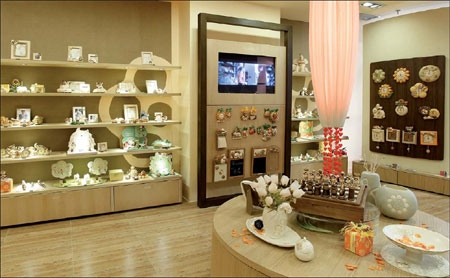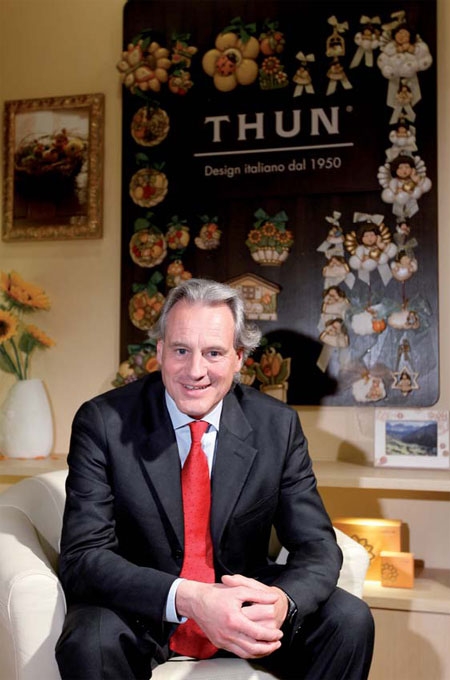Fired up

|

The first Thun boutique in China World Trade Center, Beijing. Provided to China Daily
|
Decorative-ceramics company from Italy wants to move out of Chinese factories and into middle-class homes
Aceramic sleeping angel created by Countess Lene Thun in the 1950s became a popular gift and home decoration across Europe soon after. Peter Thun, the inspiration behind the figurines and the second child of the countess, says he hopes to grow the family business by appealing to Chinese consumers.
Thun, who is the president of the eponymous ceramics maker, has flown to China at least once a month since establishing a factory in Tangshan, Hebei province, in 1990.
His visits from Italy may become more frequent now that he plans to sell his products, which now include a variety of figurines, porcelain tableware and stove heaters, in China.
In March, the first standalone Thun boutique opened in China World Trade Center in Beijing. The 330-meter-tall building is the tallest in the city and marks the company's determination of jumping into the Chinese market.
Thun says now is the time to act because Chinese consumers are more willing to buy foreign brands to decorate the swelling number of newly built apartments.
China is the brand's first sales location outside Europe. Thun regards it as a big step for his family and the company. Before launching the independent store, Thun tested the market last year in two locations in Beijing.
Thun found that its children's series was the top-selling products in China, unlike in Italy, where white ceramic pieces are more popular.
"We recovered our investment in just one month," Thun says.
Because of the quick turnaround, he decided to open a standalone store.
Thun started out as a small family business in Bolzano, Italy. Countess Lene Thun dedicated herself to the creative part of the business, while his father, Count Otmar Thun handled the administrative side. The company has grown to more than 1,700 stores throughout Europe in the past 60 years.
The first shop dedicated solely to Thun creations opened in 2004; before that, the decorative items were sold in mixed-brand shops.
|

Peter Thun, president of the ceramics maker, is expanding the business in China. Provided to China Daily
|
The Thun collection has expanded enormously. It now sells nativity scenes, animal figurines, home accessories and coffee sets.
The business continues to grow, just not at the pace it experienced before the European financial crisis hit. Previous to 2008, the Italian company regularly grew by 20 percent each year. Last year Thun had a turnover of 214 million euros, an increase of just 8 percent compared with 2010.
In an effort to cut costs, the fully handmade brand is moving its manufacturing line to Vietnam, which is 70 percent cheaper compared with making the products in China.
"From molding, casting to firing, the cost for a piece of handmade work in China is no longer cheap," Thun says.
Not to mention rising labor costs. The Ministry of Human Resources and Social Security enacted the first minimum wage law in 2004. This was to ensure the basic needs of workers to help improve performance and to promote fair competition between enterprises.
"We will continue narrowing our production scale in China, but at the same time, pushing forward sales here."
The president is calling 2012 a study year for the ceramics company.
"I'm planning to open six stores in China by the end of this year. Some resellers are coming to us to look for cooperation, but I want to reach the market by opening direct stores first. We are still learning how to choose appropriate products and places in the new marketplace," Thun says.
To appeal to the Chinese market, the ceramics company designed pieces based on the traditional 12 Chinese zodiac signs.
"We are trying to combine Chinese culture with our European style to better localize," he says.
Thun is optimistic about the home decoration needs among the rising middle class in China, which is exactly who the brand is targeting. The average price for one figurine is about 650 yuan ($103, 78 euros).
Within a generation, the middle class in China will be roughly four times the size of the American middle class population, according to the United Nations Population Division and Goldman Sachs.
"More people are moving into new houses in pursuit of higher living standards," Thun says. "Furthermore, our products are not souvenirs that connect scenic spots and people; however, they are gifts and decorations, intending to bring back childhood values, dreams, magic and warmth, connecting the relations of friends and families. We can provide modern people with emotional appeal."
There are not too many differences in gift-giving customs between Europeans and Chinese; gifts are valued for the thought, not how much money it costs, Thun says.
He expects China to account for 15 percent to 20 percent of the company's global revenue in five years.
The first Thun store was supposed to open before Christmas, peak season for buying gifts. But it took longer than expected to finalize issues, such as leasing a store, tax software and accounting.
Thun is also looking into Japan and South Korea as next possible sales markets. "That will be more challenging compared with marching into China. The home decoration market there is already mature. New brands and goods are not that acceptable, and there are not many newly built buildings."
Besides growing the business, Thun is considering other aspects of the company's future. He says his children have already shown interest in the business. He will be happy to deliver the torch to the third generation of entrepreneurs.
"When I joined the company, there were only 35 employees. But we are feeding 4,000 staff now. That has realized my parents' dream of bringing warmth to people and has become my motivation," he says.
yaojing@chinadaily.com.cn
Today's Top News
- Xi calls for promoting volunteer spirit to serve national rejuvenation
- Xi chairs CPC meeting to review report on central discipline inspection
- Reunification will only make Taiwan better
- Outline of Xi's thought on strengthening military published
- Targeted action plan to unleash consumption momentum
- Separatist plans of Lai slammed






























